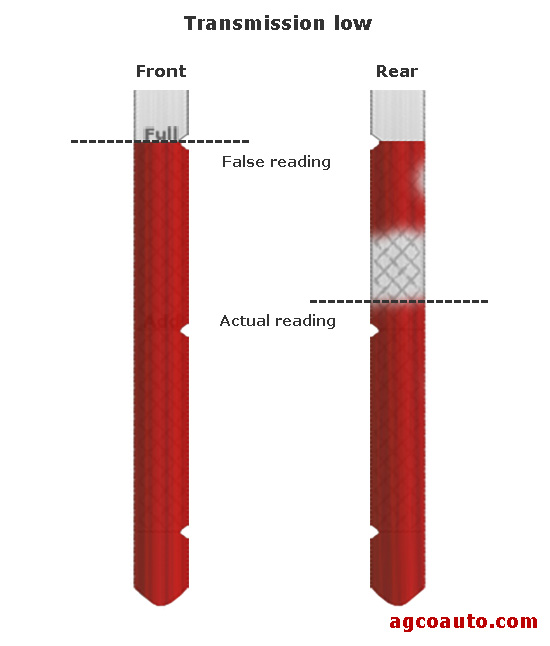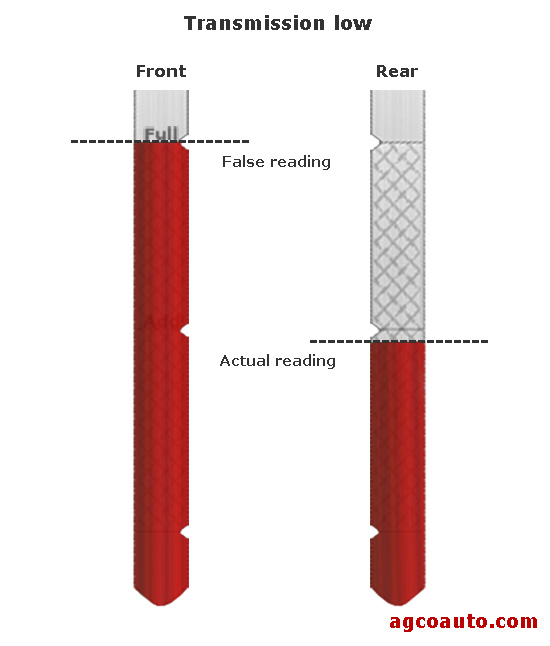You should see transmission fluid between the two marks on the dipstick. It should not be above the top mark or below the bottom mark.
Checking transmission fluid is essential for vehicle health. It helps maintain smooth shifting and prevents potential damage. But how much fluid should be on the dipstick? This question often puzzles car owners. Understanding the right level ensures your transmission works properly and lasts longer.
In this guide, we will explain how to check the fluid, what the marks mean, and why it’s crucial to maintain the correct level. Let’s dive in and make sure your car runs smoothly.

Credit: www.reddit.com
Importance Of Transmission Fluid
Transmission fluid keeps the gears moving smoothly. It helps cool the transmission system. This fluid also reduces friction. Without it, your vehicle might overheat. It ensures your car shifts gears easily. Good fluid levels mean better performance. It extends the life of your transmission. A well-lubricated system is less likely to break down. Your car will run more efficiently.
Low transmission fluid can cause serious problems. Your car might not shift gears properly. It can lead to overheating. The transmission might fail. You could face expensive repairs. Low fluid means more friction. This can damage the gears. Your car’s performance will suffer. It might not run smoothly. Always check your fluid levels. Keeping them full prevents issues.
Understanding Dipstick Measurements
The dipstick is usually near the engine. It has a bright handle. Look for a yellow or orange handle. This makes it easier to find. Pull it out gently. Wipe it clean with a rag. Reinsert it fully. Then pull it out again to check the level.
The dipstick has marks on it. These marks show the fluid level. The fluid should be between the “Full” and “Add” marks. If the fluid is below “Add,” more fluid is needed. If it is above “Full,” it may be overfilled. Always check the manual for proper levels.
Ideal Fluid Levels
Cold levels should be checked first. A lower fluid level is normal. When the engine is cold, the fluid contracts. This means the reading will be lower. Always check the fluid when the car is off.
Hot levels should be checked after driving. The fluid expands when hot. A higher level is normal. Make sure the car is running. Keep it in park. Check the dipstick level.
Always look at the markings on the dipstick. There are two lines. One for cold, one for hot. Fluid should be between these lines. Too low means add fluid. Too high means drain some.
Checking Transmission Fluid
The dipstick should show the transmission fluid level between the “Full” and “Add” marks. Check fluid when the engine is warm. Ensuring the correct level prevents transmission issues.
Preparation Steps
Park your car on a flat surface. Turn off the engine. Wait for the engine to cool. Open the hood of the car. Locate the transmission dipstick. Use the owner’s manual if you need help. Make sure you have a clean rag or paper towel. This is important for wiping the dipstick clean.
Proper Checking Techniques
Pull out the dipstick. Wipe it clean with the rag. Insert the dipstick back into its tube. Pull it out again. Look at the fluid level on the stick. The fluid should be between the “Full” and “Add” marks. If the fluid is low, add more. Use the correct type of fluid. Check the owner’s manual for this. Always avoid overfilling. This can harm the transmission.
Signs Of Incorrect Fluid Levels
Low transmission fluid can cause many problems. Your car might shift gears hard. You might hear strange noises. The car could overheat. The engine might feel sluggish. You could smell burnt fluid. The car might not move properly. These are all signs of low fluid.
Too much fluid can also be bad. You might see fluid leaking. The transmission can foam. The car might shift gears poorly. The engine might run rough. You could hear whining noises. These are signs of too much fluid.
Maintaining Proper Fluid Levels
Check the transmission fluid level often. It should be done monthly. Use a clean dipstick. Wipe it first, then insert it fully. Pull it out and check the level. The fluid should be between the “full” and “add” marks. If it is low, add more fluid. But, do not overfill. This can damage the transmission.
Add fluid if the level is below the “add” mark. Only use the recommended type of transmission fluid. Always add fluid slowly. Check the level again after adding. Repeat if needed. Remember, keeping the right amount of fluid helps your car run smoothly.
Choosing The Right Transmission Fluid
Different cars need different transmission fluids. Manual and automatic transmissions use different fluids. Automatic Transmission Fluid (ATF) is for automatic cars. Manual Transmission Fluid (MTF) is for manual cars. Always use the fluid type your car manual suggests. Using the wrong fluid can cause damage.
Car manufacturers give specific instructions for transmission fluid. Follow the manual that comes with your car. It gives the best advice. The manual lists the right fluid type and amount. This keeps your car running smoothly. Ignoring the manual can lead to problems. Always check the manual first.

Credit: www.agcoauto.com
Common Mistakes To Avoid
Many people make the mistake of overfilling or underfilling their transmission fluid. Ensure the fluid level is between the two marks on the dipstick. Proper levels prevent damage and ensure smooth driving.
Overfilling Risks
Overfilling the transmission fluid can cause serious problems. Too much fluid can create excess pressure. This pressure can damage seals and gaskets. It can also lead to leaks. Leaks are hard to fix. Always check the fluid level carefully. Make sure it is within the safe range. Use the dipstick for accurate measurement. Follow your car’s manual for guidance.
Using Incorrect Fluid
Using the wrong transmission fluid is a common mistake. Different cars need different types of fluid. Using the incorrect type can harm your car. It can cause poor shifting and damage the transmission. Always check your car’s manual. Only use the recommended fluid type. This keeps your car running smoothly and prevents costly repairs.

Credit: www.agcoauto.com
Frequently Asked Questions
How Much Transmission Fluid Should Be On The Dip Stick?
The transmission fluid on the dipstick should be between the “Full” and “Add” marks. Check while the engine is warm.
Where Should Transmission Fluid Level Be On Dipstick?
The transmission fluid level on the dipstick should be between the “Full” and “Add” marks. Check when the engine is warm.
How Do I Know If My Transmission Fluid Is Low On The Dipstick?
Check the dipstick for fluid level. If the fluid is below the “Full” or “Max” line, it’s low.
How Much Is Too Much Transmission Fluid On The Dipstick?
Too much transmission fluid on the dipstick is above the “Full” or “Max” line. Overfilling can cause damage.
Conclusion
Checking transmission fluid is easy. Keep the level between the marks on the dipstick. Regular checks help maintain your car’s performance. Low fluid can cause damage. Too much can also harm. Always use the right type of fluid for your vehicle.
Maintaining proper fluid levels ensures smooth driving. Remember, a healthy transmission means a happy car. Stay proactive with your maintenance routine. Your vehicle will thank you.
